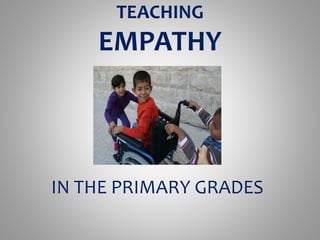
Empathy powerpoint week 5
- 1. TEACHING EMPATHY IN THE PRIMARY GRADES
- 2. What is Empathy? The ability to identify with the feelings of another or…
- 3. being able to put yourself in someone else’s shoes.
- 4. Why Teach Empathy? When students have empathy • sensitivity towards others is pervasive in the classroom • they are less likely to tease and bully
- 5. What Are the Results? A more accepting and respectful environment
- 6. What Are Primary Students Ready For? • Students age 5 can discuss hypothetical problems • Students age 8 can grapple with more complex moral issues
- 7. How Does a Teacher Promote Empathy? Step 1: Prepare Step 2: Engage Step 3: Reflect and Act
- 8. Step 1: Prepare Create conditions where empathy can thrive • Create a safe place • Lead by example • Develop emotional competency
- 9. Step 2: Engage Take Action that Suits Your Personality • Group Play • Storytelling • Immersion • Problem Solving
- 10. Step 3: Reflect and Act Action and reflection help internalize empathy • Identify Shared Values and Differences • Instill Courage • Enable Action
- 11. Image Citations Slide 1: Image found at http://bit.ly/1toT4Yx Slide 3: Image found in Clip Art search for shoes in Microsoft PowerPoint Slide 5: Image found http://slidesha.re/1ze41Aw Slide 9: Image found at http://bit.ly/1qU2rVM Slide 10: Image found at http://bit.ly/1yHsWN2 Citations Havengar, T. (2014, August 7). Empathy: the most important back to school supply. Edutopia. Retrieved from http://www.edutopia.org/blog/empathy-back-to-school-supply-homa-tavangar Kutner, L. (2007). How children develop empathy. Psych Central. Retrieved from http://psychcentral.com/lib/how-children-develop-empathy/ 0001234 Tolerance.org can be retrieved at http://www.tolerance.org/lesson/developing-empathy Wikipedia. Definition of empathy can be retrieved at http://www.edutopia.org/blog/empathy-back-to-school-supply-homa-tavangar
Editor's Notes
- Bullying is very common in schools. What can be done about it? Teaching empathy in the primary grades may decrease bullying. This presentation will give ideas about how to teach empathy in the primary grades.
- What is empathy? According to Wikipedia, “Empathy is the capacity to share or recognize emotions experienced by another. One may need to have a certain amount of empathy before being able to experience accurate sympathy or compassion.”
- An easier way to understand the meaning of empathy is to think about what it means to put yourself in someone else’s shoes. To experience what they have experienced and live what they have lived.
- According to tolerance.org “when we put ourselves in another person’s shoes, we are often more sensitive to what that person is experiencing and are less likely to tease or bully them.”
- Tolerance.org also states that “by explicitly teaching students to be more conscious of other people’s feelings, we can create a more accepting and respectful school community.”
- According to Lawrence Kutner, Ph.D. (2007) “when a child is about 5, he can learn about empathy by talking about hypothetical problems. For example asking ‘How would you feel if someone took a toy away from you?’ or ‘How would your friend feel if someone took a toy away from him?’ By the time a child is 8, he can grapple with more complex moral decisions in which he must realize that someone else’s feelings may be different from his own.”
- According to Toma Havengar (2014, August 7) there are three steps an educator should follow if he/she wants to teach empathy in the classroom. They are 1) prepare, 2) engage, and 3) reflect and act.
- Havengar states (2014, August 14) that a teacher must prepare the environment because the conditions must be right for empathy to be taught and thrive. A teacher must create a safe place. A trust-based environment is key to building empathy in students. Then the teacher must lead by example. A teacher needs to think about what empathy looks like in his/her interactions and model that because the students are watching. The final step is to develop emotional competency. In order to understand and identify the emotions of others we must first identify and manage our own emotions.
- The next step (Havengar, 2014, August 7) is to engage the students. Teachers should take action in a way that fits with the way they teach, their personality and what they enjoy doing. Some key activities would be as follows: 1) Group play -empathy begins in settings where the imagination is allowed to run free, where kids learn to solve their own conflicts and enforce their own rules like the playground. 2) Storytelling – when children hear stories the ideas they have formed in their minds are challenged, this allows them to wear the shoes of individuals whose experiences are different from theirs. 3) Immersion -by immersing students into the experiences of others , they learn to look beyond labels and stereotypes, and are able to develop a deeper understanding and 4) Problem solving – when students problem solve together empathy builds as a result of the challenges and successes they faced together.
- The third step, reflect and act, helps students to internalize empathy and then be able to make a difference in the world around them. To do this a teacher must help their students identify the shared values and the differences they have with other students. Havengar states (2014, August 7) that “empathy means recognizing the shared humanity in others but also naming and appreciating differences. This is how we move from projection, where we imagine what we would do in someone else's shoes, to empathy, where we understand and respect the decisions of another.“ The teacher must then help to instill courage in his/her students. Rather than just praise a student for their correct behaviors, an educator needs to help remove obstacles that may stand in a student’s way in the educational setting. Finally, enable action for the students. A teacher should create opportunities in the classroom, the school and/or the community where the students can put empathy into action.